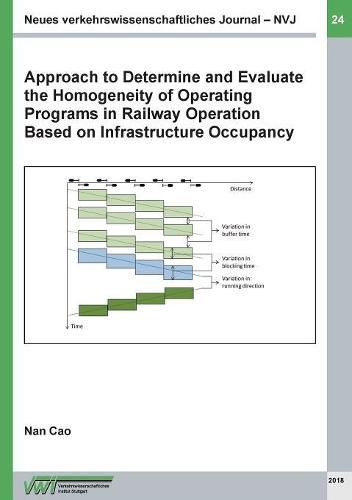Readings Newsletter
Become a Readings Member to make your shopping experience even easier.
Sign in or sign up for free!
You’re not far away from qualifying for FREE standard shipping within Australia
You’ve qualified for FREE standard shipping within Australia
The cart is loading…






This title is printed to order. This book may have been self-published. If so, we cannot guarantee the quality of the content. In the main most books will have gone through the editing process however some may not. We therefore suggest that you be aware of this before ordering this book. If in doubt check either the author or publisher’s details as we are unable to accept any returns unless they are faulty. Please contact us if you have any questions.
An efficient utilization of existing infrastructure can be achieved with a more efficient operation. However, the occupancy of infrastructure has not been discussed in the existing definitions and evaluation methods of homogeneity. An extension of existing definitions is presented from the perspective of the infrastructure, which can be characterized by variations in blocking time, buffer time and running direction. The blocking time, buffer time and running direction describe the occupancy of train path on track sections based on the blocking time model. Accordingly, the homogeneity of operating programs is evaluated through three parameters, namely the homogeneity of blocking time (HBL), the homogeneity of buffer time (HBU) and the homogeneity of running direction (HRD). The overall homogeneity (OH) combined these three parameters to realize an integrity evaluation of homogeneity of operating programs. This new methodology can quantify the homogeneity of railway operations, not only for track sections but for an entire network, which contributes significantly to the efficient utilization of infrastructure. In addition, the interrelationship between homogeneity of operating programs and operation quality were investigated quantitatively for both each parameter of homogeneity and the overall homogeneity. The operation quality deteriorates with less homogeneous timetables, in which the variation in buffer time has a more significant influence. Finally, the influence of homogeneity of operating programs in capacity research is studied for different scenarios. The low traffic flow is more sensitive to the homogeneity of buffer time and the homogeneity of blocking time is more significant for high traffic flow.
$9.00 standard shipping within Australia
FREE standard shipping within Australia for orders over $100.00
Express & International shipping calculated at checkout
This title is printed to order. This book may have been self-published. If so, we cannot guarantee the quality of the content. In the main most books will have gone through the editing process however some may not. We therefore suggest that you be aware of this before ordering this book. If in doubt check either the author or publisher’s details as we are unable to accept any returns unless they are faulty. Please contact us if you have any questions.
An efficient utilization of existing infrastructure can be achieved with a more efficient operation. However, the occupancy of infrastructure has not been discussed in the existing definitions and evaluation methods of homogeneity. An extension of existing definitions is presented from the perspective of the infrastructure, which can be characterized by variations in blocking time, buffer time and running direction. The blocking time, buffer time and running direction describe the occupancy of train path on track sections based on the blocking time model. Accordingly, the homogeneity of operating programs is evaluated through three parameters, namely the homogeneity of blocking time (HBL), the homogeneity of buffer time (HBU) and the homogeneity of running direction (HRD). The overall homogeneity (OH) combined these three parameters to realize an integrity evaluation of homogeneity of operating programs. This new methodology can quantify the homogeneity of railway operations, not only for track sections but for an entire network, which contributes significantly to the efficient utilization of infrastructure. In addition, the interrelationship between homogeneity of operating programs and operation quality were investigated quantitatively for both each parameter of homogeneity and the overall homogeneity. The operation quality deteriorates with less homogeneous timetables, in which the variation in buffer time has a more significant influence. Finally, the influence of homogeneity of operating programs in capacity research is studied for different scenarios. The low traffic flow is more sensitive to the homogeneity of buffer time and the homogeneity of blocking time is more significant for high traffic flow.